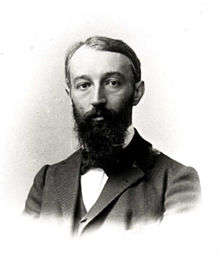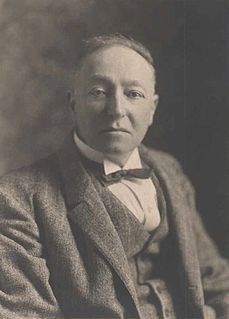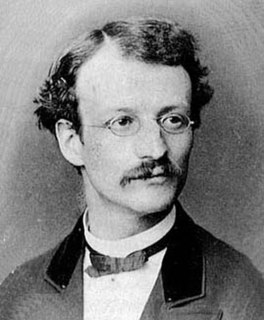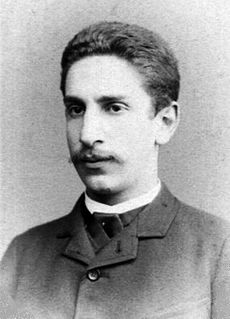
Christian Felix Klein was a German mathematician and mathematics educator, known for his work with group theory, complex analysis, non-Euclidean geometry, and on the associations between geometry and group theory. His 1872 Erlangen program, classifying geometries by their basic symmetry groups, was an influential synthesis of much of the mathematics of the time.

Arthur Moritz Schoenflies, sometimes written as Schönflies, was a German mathematician, known for his contributions to the application of group theory to crystallography, and for work in topology.

Eduard Study, more properly Christian Hugo Eduard Study, was a German mathematician known for work on invariant theory of ternary forms (1889) and for the study of spherical trigonometry. He is also known for contributions to space geometry, hypercomplex numbers, and criticism of early physical chemistry.

Jean Alexandre Eugène Dieudonné was a French mathematician, notable for research in abstract algebra, algebraic geometry, and functional analysis, for close involvement with the Nicolas Bourbaki pseudonymous group and the Éléments de géométrie algébrique project of Alexander Grothendieck, and as a historian of mathematics, particularly in the fields of functional analysis and algebraic topology. His work on the classical groups, and on formal groups, introducing what now are called Dieudonné modules, had a major effect on those fields.

Oskar Perron was a German mathematician.

Hieronymus Georg Zeuthen was a Danish mathematician.

Jan Arnoldus Schouten was a Dutch mathematician and Professor at the Delft University of Technology. He was an important contributor to the development of tensor calculus and Ricci calculus, and was one of the founders of the Mathematisch Centrum in Amsterdam.

Gerhard Hessenberg was a German mathematician. He received his Ph.D. from the University of Berlin in 1899 under the guidance of Hermann Schwarz and Lazarus Fuchs. His name is usually associated with projective geometry, where he is known for proving that Desargues' theorem is a consequence of Pappus's hexagon theorem, and differential geometry where he is known for introducing the concept of a connection. He was also a set theorist: the Hessenberg sum and product of ordinals are named after him. However, Hessenberg matrices are named for Karl Hessenberg, a near relative.

Moritz Pasch was a German mathematician of Jewish ancestry specializing in the foundations of geometry. He completed his Ph.D. at the University of Breslau at only 22 years of age. He taught at the University of Giessen, where he is known to have supervised 30 doctorates.

Alexander Dinghas was a Greek mathematician.
In differential geometry, the Carathéodory conjecture is a mathematical conjecture attributed to Constantin Carathéodory by Hans Ludwig Hamburger in a session of the Berlin Mathematical Society in 1924. Carathéodory did publish a paper on a related subject, but never committed the Conjecture into writing. In, John Edensor Littlewood mentions the Conjecture and Hamburger's contribution as an example of a mathematical claim that is easy to state but difficult to prove. Dirk Struik describes in the formal analogy of the Conjecture with the Four Vertex Theorem for plane curves. Modern references to the Conjecture are the problem list of Shing-Tung Yau, the books of Marcel Berger, as well as the books.

Ludwig Schlesinger, was a German mathematician known for the research in the field of linear differential equations.

Alexander Wilhelm von Brill was a German mathematician.

Georg Scheffers was a German mathematician specializing in differential geometry. He was born on 21 November 1866 in the village of Altendorf near Holzminden. Scheffers began his university career at the University of Leipzig where he studied with Felix Klein and Sophus Lie. Scheffers was a coauthor with Lie for three of the earliest expressions of Lie theory:

Eugenio Bertini was an Italian mathematician who introduced Bertini's theorem. He was born at Forlì and died at Pisa.

Gino Benedetto Loria was a Jewish-Italian mathematician and historian of mathematics.
Heinrich Wilhelm Ewald Jung was a German mathematician, who specialized in geometry and algebraic geometry.

Willi Ludwig August Rinow was a German mathematician who specialized in differential geometry and topology. Rinow was the son of a schoolteacher. In 1926, he attended the Humboldt University of Berlin, studying mathematics and physics under professors such as Max Planck, Ludwig Bieberbach, and Heinz Hopf. There, he received his doctorate in 1931. In 1933, he worked at the Jahrbuch über die Fortschritte der Mathematik in Berlin. In 1937, he joined the Nazi Party. During 1937—1940, he was an editor of the journal Deutsche Mathematik. In 1937, he became a professor in Berlin and lectured there until 1950. His lecturing was interrupted because of his work as a mathematician at the Oberspreewerk in Berlin from 1946 to 1949.

Ernst August Weiß was a German mathematician.

















